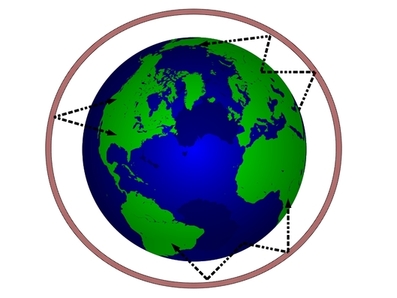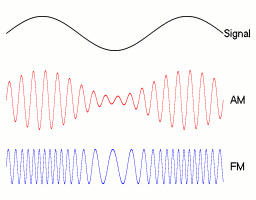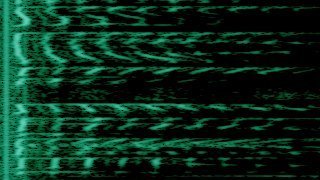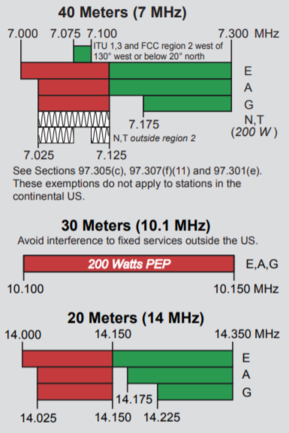Radio concepts: Bands and modes
This is the first in a series of beginner-friendly posts on radio concepts. In amateur radio, you’ll hear a lot of terms like “VHF”, “2 meters”, “FM”, “single sideband” and so forth. These give essential information about a radio signal. So, what do all the terms mean? I’ll try to keep it simple, with some more technical info in links and footnotes.
Frequency and wavelength
The most basic property of a radio wave is its frequency. As a wave moves past an antenna, it creates a positive voltage, then a negative voltage, then back to positive and so on.1 The number of complete cycles per second is the frequency, measured in hertz (Hz). So a radio wave with frequency 500 kHz (500,000 Hz) goes from positive to negative and back 500,000 times per second. A FM radio station on 96.5 MHz completes a cycle 96,500,000 times per second.
Instead of frequency we can also talk about wavelength, which is the distance between consecutive wave peaks (or troughs) in space, at a single instant in time.

Radio waves travel at the speed of light,2 so there is a strict relationship between frequency and wavelength:
Because the speed of light is very close to 300,000,000 meters per second, we can use this approximation:
For example, that FM radio station at 96.5 MHz has a wavelength of approximately 300 / 96.5 = 3.1 meters. WiFi at 2.4 GHz (2400 MHz) has a wavelength around 300 / 2400 = 0.125 meters = 12.5 centimeters.
Wavelength is particularly important because the size of an antenna, generally speaking, is proportional to the wavelength of the signals it needs to transmit or receive. Longer wavelengths (lower frequencies) require larger antennas.
Bands
It is useful to group ranges of frequencies into bands, because different frequencies have different physical properties and applications. People have found uses for radio waves all the way from a few Hz to hundreds of GHz and beyond.3 However, the most widely-used frequencies in ham radio fall into three general ranges:
-
HF (“high frequency”). Officially4 covers the range 3 – 30 Mhz. The special thing about HF radio waves is that they reflect off of the ionosphere, a layer of Earth’s upper atmosphere. By bouncing between Earth’s surface and the ionosphere, HF signals can travel extremely long distances, far beyond the horizon.

For long distance radio, you can’t beat HF. But the disadvantages are many: large antennas, expensive radios, lots of knowledge and time investment required.
HF propagation depends on many factors such as time of day, solar flares, and the 11-year sunspot cycle. A HF frequency that works great for global communication might stop working just a few minutes later. Currently (2019) we are near a sunspot minimum, which makes HF more challenging; however there is still a lot of fun to be had.
Besides amateur radio, you will also find shortwave broadcasts, numbers stations, military radar systems and other stuff in this range. CB radio sits at the high end of HF, just below the amateur 10 meter band.
-
VHF (“very high frequency”), spanning 30 – 300 MHz. VHF is mainly used for local communication and, unlike HF, is suitable for handheld radios. VHF usually does not bounce off the ionosphere, and will not go over the horizon, although dedicated VHF enthusiasts find ways around that. VHF is also limited by line-of-sight; it will not travel through obstructions such as hills.
Besides hams, other users of VHF include FM broadcasts, some TV channels, air traffic control, MURS, police/fire/EMS and lots more.
-
UHF (“ultra high frequency”), spanning 300 MHz – 3 GHz. The lower end of UHF is similar to VHF in characteristics and uses. It is the home of FRS/GMRS in the USA, and the similar PMR446 in Europe.
The upper end of UHF includes cell phones and WiFi. Hams have privileges on the 2.4 GHz frequencies used by WiFi, and can operate WiFi hardware at much higher power, subject to amateur radio rules.
As you can see, the terminology is archaic; “high frequency” is actually towards the low end of frequencies in use today!
Amateur bands
When hams speak of “bands” we usually mean a specific range of frequencies reserved for amateur use. These are identified by approximate wavelength, e.g. “80 meter band” or “70 centimeter band”. You’ll need to consult a chart to find the exact frequency limits and privileges, which vary by country and by license type.
(excerpt from ARRL band chart)
The most important bands for local communication are 2 meters and 70 centimeters. Most handheld radios, including the ubiquitous Baofengs, will support both. Because of line-of-sight limitations, repeaters are very common on these bands. A repeater is a fixed station on a hilltop or tall building, which receives a signal on one frequency and simultaneously retransmits it on another. Because the repeater has a better location, better antenna and more power than your handheld radio, it can vastly extend your effective range — sometimes to 100 miles or more. A full write-up about repeaters is out of scope here, but you can find a wealth of information online.

(own work)
To complicate things, hams will sometimes say “VHF” to mean 2 meters and “UHF” to mean 70 centimeters, even though there are other amateur bands within VHF and UHF as defined above.
On HF a whole bunch of bands are available. The best choice at any point in time depends on many factors such as time of day, ionospheric conditions, the space available for antennas and the license privileges of the operator. At the current sunspot minimum, lower frequencies like 40 and 20 meters are open on a daily basis, while the higher frequencies like 10 meters are only sporadically open for long-distance communication.
Voice modes
A constant radio wave on a single frequency doesn’t convey any information beyond “I’m here!”. In order to send a message — be it voice, text, or something else — we need to vary the radio wave over time. This is where modulation modes come in.
Amplitude modulation (AM) is one simple way to transmit audio. The amplitude (strength) of the radio wave varies according to the amplitude of the sound wave. Because AM transmitters are easy to build and AM receivers are even simpler, AM was the first voice mode. It is still used for broadcasting and some other things, but has largely been replaced by FM and SSB on ham radio (see below).
Frequency modulation (FM) is another audio mode. Instead of varying amplitude over time, we vary frequency. FM produces clear audio and is the dominant mode for local communication on VHF and UHF. Most handheld radios do FM and only FM. The main downside is that a FM signal has a large bandwidth: it occupies a large range of frequencies. For this reason and others, FM is not used on HF bands.

Single sideband (SSB) is a more efficient form of AM. Although AM is different from FM, the varying amplitude nonetheless spreads the signal over a range of frequencies.

In this waterfall plot of an AM signal, the horizontal axis is frequency, the vertical axis is time, and the color indicates signal strength. The strong red signal in the center is the carrier and contains no information by itself. Also, there are two copies of the audio signal: one above the carrier, the other below. These are the upper and lower sidebands. In other words, the AM signal has a lot of redundancy. By transmitting just one sideband and no carrier, we can save on both power and bandwidth.

(same image source)
This waterfall shows an upper sideband (USB) signal. The lower sideband (LSB) would be the same, except flipped left-to-right. For historical reasons, LSB is used on the lower HF bands (up to 40 meters) while USB is used at higher frequencies.5
The main disadvantage of SSB is that it requires more complex electronics in both the transmitter and receiver, which is why SSB did not catch on until the 1960s. With modern electronics it is easy to send and receive SSB. Aside from a few diehard AM users, SSB has taken over as the voice mode for HF ham radio.
Digital voice modes encode audio as a stream of bits before sending it. There are a number of digital modes in use, mainly on VHF and up. I don’t do digital voice so I don’t have much to say about it!
Other modes
Continuous wave (CW) is the oldest6 radio mode. It works by switching a transmitter on and off to represent the dots and dashes of Morse code. Although Morse proficiency is no longer required to get a ham license in most countries, it is still a very popular mode. CW occupies a very small (though nonzero) bandwidth, and works well even when signals are weak, because the human ear is very good at picking out the rhythmic beeps of Morse code. CW-only radio kits are the most affordable way to get into HF.
The downside of CW, or upside depending on how you look at it, is that you have to learn Morse code! Skilled CW operators don’t hear individual dots and dashes; they recognize the rhythms of letters or entire words and phrases. It’s like learning a spoken language or a percussion instrument. Many tools and resources are available for learning Morse code, too many to list here.
Digital data modes allow sending digital data over ham radio. Typically this involves an audio connection between a radio and a computer’s sound card. The computer translates data to and from audio tones, much like an old-school phone-line modem. Sometimes a dedicated device takes the place of the computer, or the functionality might be built into the radio itself.
A large number of digital modes are used for different purposes. Some of the more popular ones are FT8, JS8, RTTY, PSK31, and APRS.
Slow-scan television (SSTV) is a way of sending images over ham radio. Despite the term “television”, we are talking about grainy still images sent over the course of several seconds or minutes. If you miss the excitement of waiting for JPEGs to load over dial-up internet then this is the mode for you. Because images are sent so slowly, they fit into the same bandwidth as a single SSB voice signal.
Amateur television (ATV), by contrast, is full-motion video and audio sent using the same technology as commercial broadcast TV. This requires a lot of bandwidth (6 MHz) so it’s only done on the higher-frequency bands (70 centimeters and up) where there is more room.
That’s it for now! Hope you found this informative and stay tuned for more content. There is lots more to say about modes so check out Wikipedia or the ARRL website if you’d like to know more.
Footnotes
-
The radio wave itself consists of an electric field and a magnetic field, oscillating together, hence “electromagnetic (EM) radiation”. These are vector fields, meaning that they have both a magnitude (strength) and a direction at each point in space. The voltage detected by your radio is a scalar quantity — magnitude only, whether positive or negative. Usually it’s produced by the electric field, which induces an electrical current in your antenna. But there are some antennas, such as magnetic loop antennas, where the magnetic field does the work instead. ↩
-
The actual speed depends on what material the light or radio wave is moving through. Light is fastest in a vaccum, and about 0.03% slower in air. Radio waves travel up to 1/3 slower in wire or coaxial cable. The ratio of the speed in a material to the speed in vacuum is called the velocity factor. It’s important to account for velocity factor when designing antennas. In optics, the reciprocal of the velocity factor is called the index of refraction. ↩
-
The light we see is also an electromagnetic wave, at a really high frequency like 300 THz (300,000 GHz). At even higher frequencies you get ultraviolet light, then X-rays, then gamma rays. In between radio frequencies and infrared light, there is a “terahertz gap” where neither radio technology nor optical technology works very well, making it difficult to utilize those frequencies. ↩
-
A lot of ham HF equipment can transmit down to 1.8 MHz, the bottom of the 160 meter band, even though that is technically medium frequency and not HF. Some can also transmit on 6 meters, at the low end of VHF. 6 meters is known as the “magic band” because it’s quite unpredictable and has characteristics of both HF and VHF. ↩
-
And on 60 meters, which is a special case in many respects. ↩
-
Actually, not quite. The very first radio transmitters used an electric spark to excite a resonant circuit, kind of like hitting a bell with a hammer. This produces a damped wave that fades out until the next spark happens. Damped waves are extremely wasteful of bandwidth and are no longer allowed. Once continuous wave took over, the term CW became synonymous with Morse code itself. But a CW signal is not actually continuous; it switches on and off with the pattern of Morse dots and dashes. ↩
